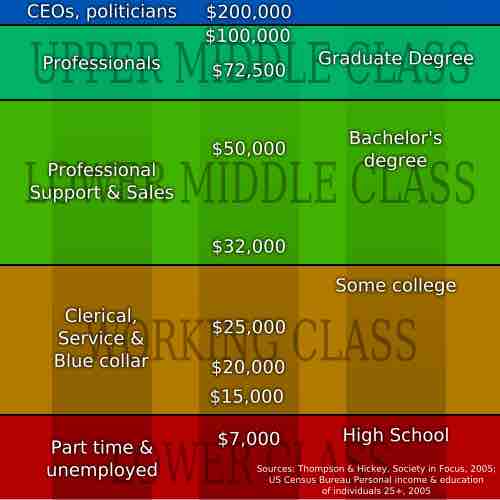Most social scientists in the U.S. agree that society is stratified into social classes. Social classes are hierarchical groupings of individuals that are usually based on wealth, educational attainment, occupation, income, or membership in a subculture or social network. Social class in the United States is a controversial issue, having many competing definitions, models, and even disagreements over its very existence. Many Americans recognize a simple three-tier model that includes the upper class, the middle class, and the lower or working class. Some social scientists have proposed more complex models that may include as many as a dozen class levels. Meanwhile, some scholars deny the very existence of discrete social classes in American society. In spite of debate, most social scientists do agree that in the U.S. people are hierarchically ranked in a social class structure.
Models of U.S. Social Classes
A team of sociologists recently posited that there are six social classes in America. In this model, the upper class (3% of the population) is divided into upper-upper class (1% of the U.S. population, earning hundreds of millions to billions per year) and the lower-upper class (2%, earning millions per year). The middle class (40%) is divided into upper-middle class (14%, earning $76,000 or more per year) and the lower-middle class (26%, earning $46,000 to $75,000 per year). The working class (30%) earns $19,000 to $45,000 per year. The lower class (27%) is divided into working poor (13%, earning $9000 to 18,000 per year) and underclass (14%, earning under $9000 per year). This model has gained traction as a tool for thinking about social classes in America, but it does not fully account for variations in status based on non-economic factors, such as education and occupational prestige. This critique is somewhat mitigated by the fact that income is often closely aligned with other indicators of status; for example, those with high incomes likely have substantial education, high status occupations, and powerful social networks.

United States Social Classes
While social scientists offer competing models of class structure, most agree that society is stratified by occupation, income, and educational attainment.
A commonly used model for thinking about social classes in the U.S. attributes the following general characteristics to each tier: the upper class has vast accumulated wealth and significant control over corporations and political institutions, and their privilege is usually inherited; the corporate elite consists of high-salaried stockholders, such as corporate CEOs, who did not necessarily inherit privilege but have achieved high status through their careers; the upper-middle class consists of highly educated salaried professionals whose occupations are held in high esteem, such as lawyers, engineers, and professors; the middle class (the most vaguely defined and largest social class) is generally thought to include people in mid-level managerial positions or relatively low status professional positions, such as high school teachers and small business owners; the working class generally refers to those without college degrees who do low level service work, such as working as a sales clerk or housekeeper, and includes most people whose incomes fall below the poverty line. In the above outline of social class, status clearly depends not only on income, but also occupational prestige and educational attainment.
Debates over the Existence and Significance of U.S. Social Classes
According to the "American Dream," American society is meritocratic and class is achievement-based. In other words, membership in a particular social class is based on educational and career accomplishments. Many sociologists dispute the existence of such class mobility and point to the ways in which social class is inherited. For example, a son or daughter of a wealthy individual may carry a higher status and different cultural connotations than a member of the nouveau riche ("new money"). Likewise, being born into a particular social class may confer advantages or disadvantages that increase the likelihood that an adult will remain in the social class into which they were born.
Social theorists who dispute the existence of social classes in the U.S. tend to argue that society is stratified along a continuous gradation, rather than into delineated categories. In other words, there is inequality in America, with some people attaining higher status and higher standards of living than others. But there is no clear place to draw a line separating one status group from the next. Whether one ascribes to the view that classes are discrete groups or levels along a continuum, it is important to remember that all social classes in the United States, except the upper class, consist of tens of millions of people. Thus social classes form social groups so large that they feature considerable internal diversity and any statement regarding a given social class' culture should be seen as a broad generalization.